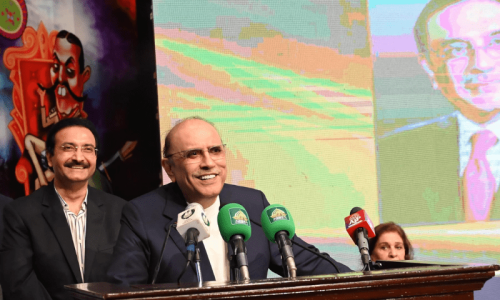Contrary to popular misconception, agricultural income in Pakistan is already taxed. However, it differs from other forms of income in two key ways. First, the collection of agricultural income tax (AIT) falls under the jurisdiction of the provinces. Second, the maximum tax rate for agricultural income is just 15 per cent in Punjab and Sindh — far lower than the rates for salary and business income.
After the federal budget announcement, the government has been under rising pressure from various quarters — particularly salaried class — to align AIT rates with the federal business income rates, to ensure horizontal equity — people with the same income should pay the same amount in taxes.
One of their arguments posits that total revenue collection under the AIT is less than Rs4 billion, which accounts for less than 0.01pc of the national GDP. The amount seems negligible when juxtaposed with the sector’s sizable 24pc contribution to the GDP, amounting to Rs22 trillion.
Basically, the agriculture sector comprises several subsectors such as crops, livestock and dairy (including poultry), fisheries and forestry. Nevertheless, the crops subsector is often wrongfully equated with the entire agriculture sector, and thus landlords are only discussed when it comes to tax concessions.
Requiring all farmers with more than 12 acres to file agriculture income tax returns would result in around 0.7m returns annually, which will require an institutional setup at least one-fifth the size of the FBR
In reality, the crop subsector contributes a mere 8.54pc to the country’s GDP, while the rest of the subsectors contribute 15.46, comprising 64.48pc of the agriculture sector.
In Punjab and Sindh provinces, which together account for roughly 90pc of Pakistan’s agriculture sector (crops subsector), AIT is both land-based and income-based; farmers must pay whichever one is higher. Almost all large farmers submit their income-based AIT returns with the provincial Revenue Department as well as another with the Federal Board of Revenue (FBR) to get “filer” benefits.
Reportedly, the declared taxable income often does not correspond to the land’s income-generating potential. In some cases, where farmers also have other businesses, tax sheltering — parking business income under agriculture — is common.
Small and medium farmers — with the exception of a few, mostly those with multiple income sources — typically opt for a fixed land-based AIT, which is a nominal amount ranging from Rs200-500 per acre, amounting to hardly 1-2pc of net earnings per acre. This indicates a considerable potential for AIT increase.
Yet, unlike other sectors, AIT collection is bound to decline over time. Due to land division among family members over successive generations — either due to the land owner’s death or deliberate title transfer to avoid the rumoured tax rate of up to 45pc — medium and large farms are bound to shrink with every passing year. Most may end up less than 12 acres, eventually below the annual AIT income threshold of Rs0.6 million (in Punjab).
The agriculture sector primarily produces basic commodities, not value-added products, therefore, margins are not appreciably higher. Additionally, 10.3m farms (estimated as of 2024) only contribute a mere 8.54pc to GDP, therefore, using GDP contribution as a benchmark for tax potential is not so straightforward.
Certainly, aligning the taxation of large landlords — particularly absentee ones — with the FBR’s business income rates seems justified. However, the plight of small and medium farmers must be taken into account when designing the new AIT regime.
Farmers may transfer land to family to avoid IMF’s proposed 45pc tax rate, reducing AIT revenue even more
Over the past two years, the prices of agricultural inputs have skyrocketed while crop prices have declined. As a result, farmers’ profitability has drastically reduced, leaving them struggling to survive.
For decades, farmers have been facing huge implicit taxes due to government policies, particularly those aimed at suppressing prices of agricultural produce to benefit urbanites or the agro-processing sector.
Farmers, in fact, have to pay implicit taxes when the government takes measures like imposing an export ban, restricting inter-provincial movement, and controlling prices through notifications.
In no other sector does the government exert such control over goods under the pretext of food security and food inflation. Many studies reveal that such implicit taxation results in inter-sectoral resource transfers amounting to around $1bn-2bn every year — exceeding the total subsidies allocated to the agriculture sector.
Another critical issue is the assessment of agricultural income. Owing to significant variations in crop yields from farm to farm and extensive price fluctuation of crops, even within weeks, pose significant challenges for calculating farmers’ profitability for tax purposes.
Being a part of the informal economy, the social and operational readiness levels of small and medium farmers are still inadequate in maintaining accounting books.
Furthermore, requiring all farmers with more than 12 acres to file AIT returns would result in around Rs0.7m in returns annually, which will require an institutional setup at least one-fifth the size of the FBR. Consequently, there is a risk that the cost to the provincial governments might exceed the incremental AIT revenue.
Globally, there are four prevalent methods of AIT assessment: land-based, rental value of land, actual income and presumptive income. However, regardless of the chosen method, the system should adhere to fundamental taxation principles including simplicity, minimum discretionary powers, administrative feasibility, and cost-effective collection.
In conclusion, levying AIT on small and medium farmers is worth considering, based on presumed income (presumptive taxation) using the existing Produce Index Unit of land — a proxy that measures land productivity by taking into account soil type, mode of irrigation, and agro-climatic zone.
However, farmers with over 50 acres of land (irrigated) should be taxed similarly to business income under the AIT regime, following the principles of progressive taxation and vertical equity.
Khalid Wattoo is a farmer and a development professional, and Dr Waqar Ahmad is a former Associate Professor at the University of Agriculture, Faisalabad.
Published in Dawn, The Business and Finance Weekly, July 22nd, 2024













































